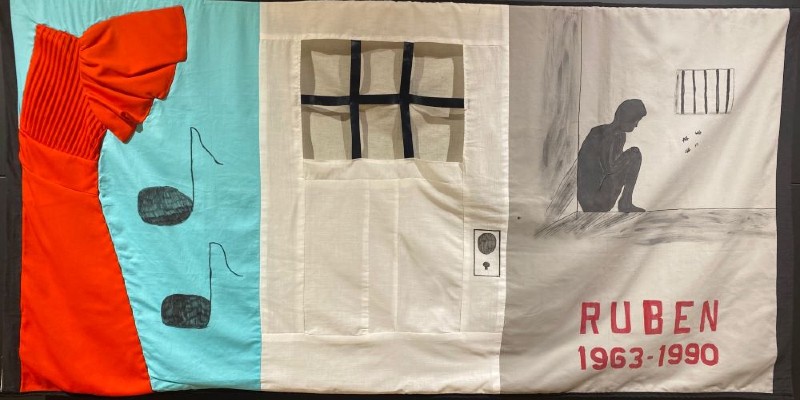*Editor’s note: The title of this article was edited to eliminate the use of stigmitizing language about people of have lost their lives to AIDS-related illness. The CDC offers more information about using appropriate language when speaking or writing about HIV/AIDS.
Ruben, Pat, Bobby, Chuck, Scott, Mike, Stephen, David, Ronald, John, Paco, Benji, Scott, Bob, Devin, Mike, Merrill, Michael, Grant, Greg.
They were sons, brothers, partners, friends, and in some cases fathers. Some of their lives and deaths are well documented, some aren’t known by more than a first name, but at one time, they were known to someone.
These are the men that are immortalized in the careful stitching of 19 quilted panels, now hanging at Spurlock Museum in an exhibit that opened November 2nd. Sewn in Memory: AIDS Quilt Panels from Central Illinois, captures the lives of men who died at the height of the AIDS crisis, all with ties to this area.
Earlier this fall, the National Mall was filled with small white flags signifying the hundreds of thousands of Americans who’ve died from COVID-19 since the beginning of the pandemic. In October of 1987, a massive quilt covered the same space, made up of nearly 2000 panels made with love by friends, family members, and sometimes strangers, honoring lives that were taken by AIDS. It grew to more that 8000 panels by the following year. Now, it has more than 50,000.
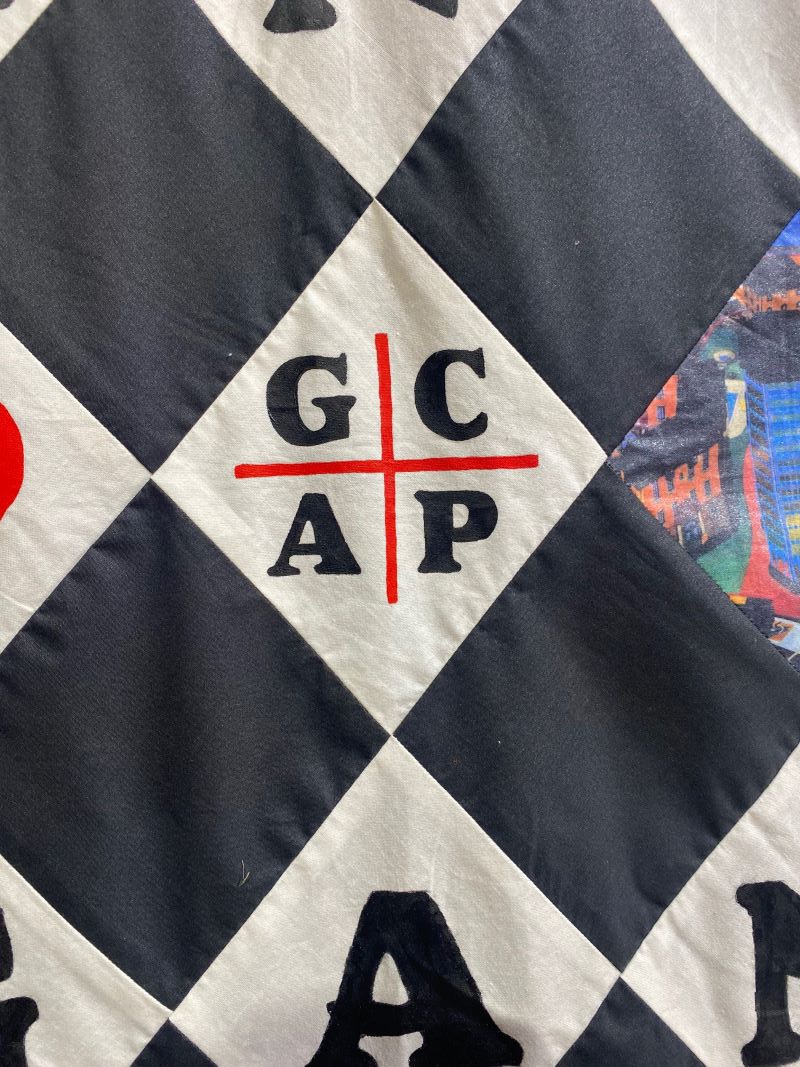
In his will, John left money to GCAP to finish a transitional home for those with HIV who were experiencing homelessness. ©Artist unknown. In memory of John Morgan. Property of GCAP, Urbana, IL. Photo by Julie McClure with permission from Spurlock Museum.
Champaign-Urbana has it’s own collection of quilt panels — some that have remained in the area, some that were duplicated and sent off to be a part of the national quilt. Those that remained have been under the care of the Greater Community AIDS Project (GCAP), an organization founded in 1985 (formerly know as the Gay Community AIDS Project) as AIDS cases began to appear in Champaign-Urbana.
Jerry Carden, founding member of GCAP, remembers that time well. He met his now husband in 1981, just as a new disease named GRID was making headlines. “We were all kind of scared…but didn’t expect we’d have it as bad as in places like San Francisco or New York…but we were also thinking it’s really ‘Pollyana-ish’ to think that we wouldn’t be affected here too.” Carden’s background is in biology, health education, and community health, and at the time he was working for Burnham Hospital. As he and other concerned community members saw the AIDS epidemic reach C-U, GCAP was born. It had a two pronged mission, with one group organizing around direct support for those suffering from the disease, and the other educating the community.
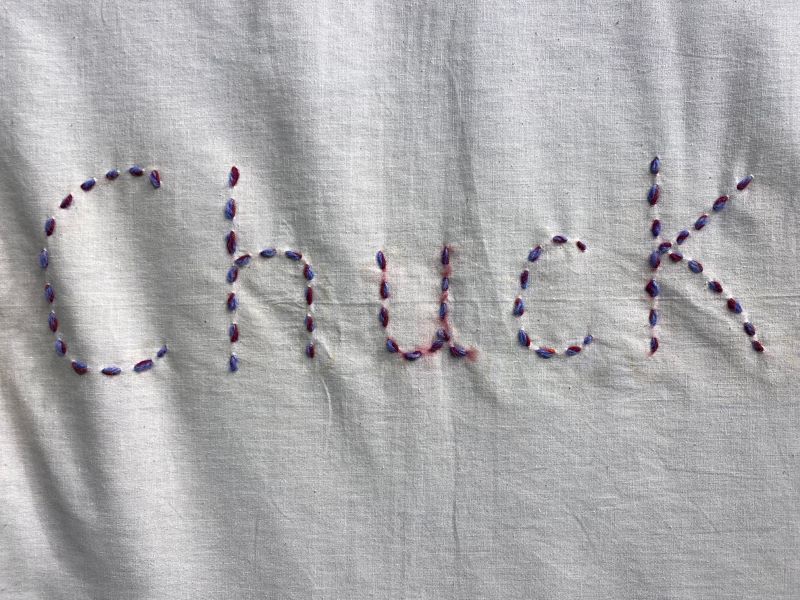
Chuck could always be counted on to help others. © Kari Alice Lynn, Thom Baxley, and others. In memory of Chuck Harshbarger. Property of GCAP, Urbana, IL. Photo by Julie McClure with permission from Spurlock Museum.
According to Carden, the idea to create the quilt panels locally grew organically, as members of GCAP and others began losing friends. A group would gather in the evenings at McKinley Foundation, some volunteering to sew panels for people they’d never met.
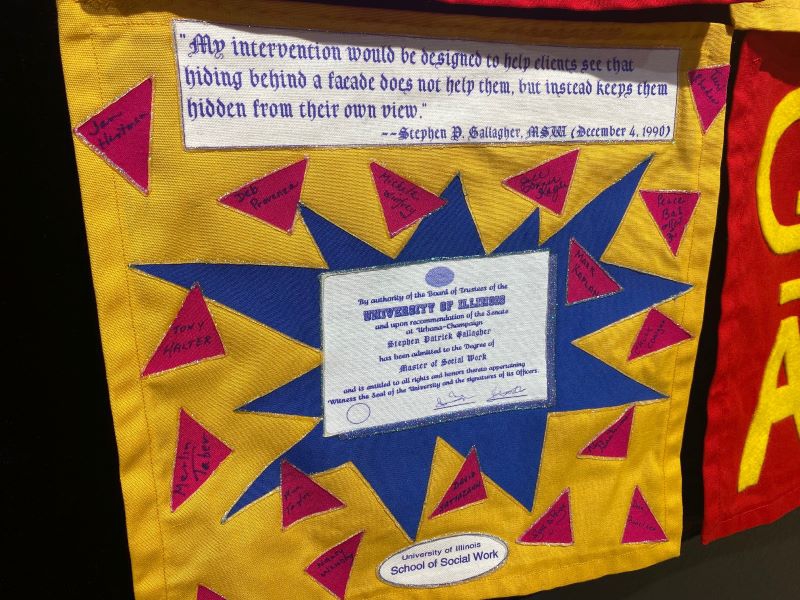
Stephen Gallagher was bestowed his Master of Social Work posthumously. ©Jerry Carden, Steve Otto, and others. In memory of Stephen Gallagher. Propery of GCAP, Urbana, IL. Photo by Julie McClure with permission from Spurlock Museum.
Carden and his husband worked on panels as well, in their home. One of those panels hangs in the exhibit. Stephen Gallagher was a member of GCAP, and Carden’s dear friend. Carden collaborated with others who knew Gallagher to create the elaborate quilt piece. Gallagher made one of the quilts hanging in the exhibit as well — he was a “buddy” to Mike Hyman, providing support for him and his family after his diagnosis.
The panels created here in C-U have been used in many ways over the years. They’ve been displayed in honor of World AIDS Day and for GCAP fundraisers, and they’ve appeared in the 4th of July parade, long before the Pride parade existed in C-U.
How did they come to hang on the walls at Spurlock Museum? It’s a bit of a long story, and a story that highlights the sort of serendipitous collaborations that are possible in a community such as this.
University of Illinois has a relatively new course, History Harvest, where students gather historical stories and documents from the area. Students in the Spring 2021 course were interested in focusing on local LGBTQ+ history, and a connection was made between U of I History Professor Kathy Oberdeck and Beth Watkins, Education and Publications Coordinator at Spurlock. Watkins spoke to the class about Spurlock’s drag exhibit, and met Carden, who was presenting as well. The class was going to collaborate with GCAP to digitize the local AIDS quilt panels. Watkins stepped in and offered to help, as Spurlock is well-equipped to photograph textiles. As conversations continued, Carden noted the upcoming 40th anniversary of the onset of AIDS in the U.S., and expressed a desire to display the photos or quilt panels in some fashion. Watkins thought, “Oh, we have display space!”
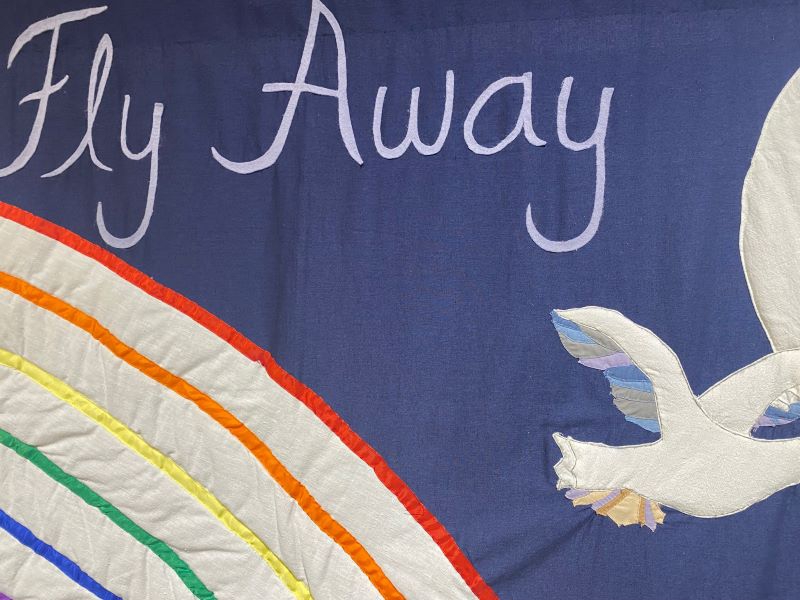
Devin grew up in Deland and Monticello, and was an active member of GCAP’s Buddies Program. ©Artist unknown. In memory of Devin Carrington. Property of GCAP, Urbana, IL. Photo by Julie McClure with permission from Spurlock Museum.
Says Watkins, “I knew it was planned to be empty this fall, and I thought with the empathy that we all have for understanding an epidemic right now it just seemed perfect.” The project was quickly approved and the wheels were set in motion. It was an exhibit that had the capacity to say a lot without much elaboration and staging. “We knew that these don’t need interpreting. You can just look at them and let the stories wash over you, and think about who were these individual people.”
The exhibit is simple but powerful: Nineteen panels displayed on black walls, each with a short description of who each man was, with whatever information is known. For a few of the men, it’s not much, despite the best efforts of GCAP and Watkins. According to Katya Reno, Marketing and Coordinations Coordinator for the museum, the absence of information is part of the story. “The News-Gazette was terrible at the time about reporting on this, and they wouldn’t write obituaries for some of the people who died. Some of these silences speak to the problem.” In other cases, there just aren’t friends and family around anymore to fill in the details. She hopes as people learn about and visit the exhibit, they will encounter people with more information.
Eventually, there will be a video component to the exhibit. WILL is working on a series of documentary features about the AIDS crisis in C-U, and a group of journalism students has taken on the task of producing short videos about each of the men in the exhibit. Once completed, those videos will be added to the display.
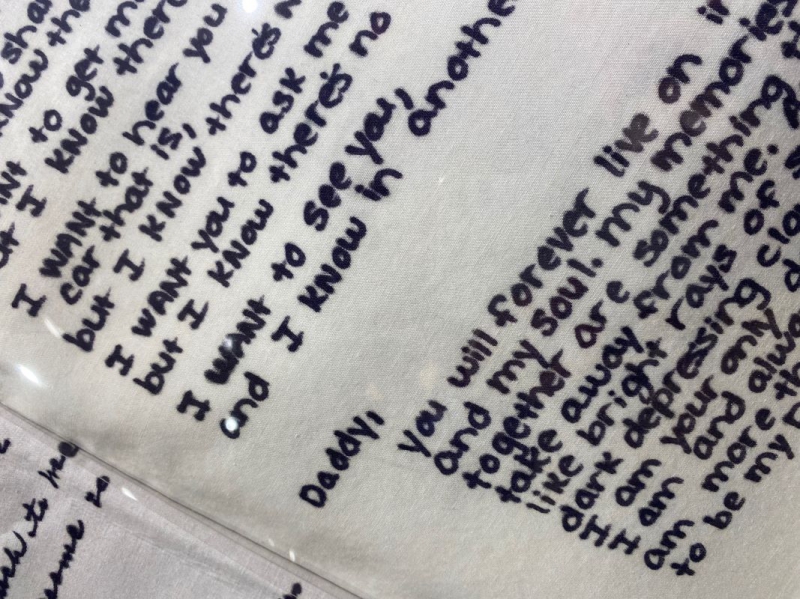
Merrill was a Vietnam veteran, and had a wife and children before coming out. He maintained a close relationship with with his ex-wife. ©Merrill Eskew’s Family. In memory of Merrill Eskew. Property of GCAP, Urbana, IL. Photo by Julie McClure with permission from Spurlock Museum.
It’s difficult to walk into the exhibit and not feel the weight of each loss of life represented. All these years later, Carden still feels it. He felt it when they brought the panels out of storage this summer. He even remembers the date: July 12th. “There were two that I knew really really well. Steve Gallagher was my best friend outside of my relationship, and then Merrill Eskew. When those went up I was surprised how hard I was hit. [Even though] I’d seen them before.”
Watkins emphasizes the importance of sitting with that heaviness a bit. “I’m really hoping people will be willing to acknowledge their grief when they come into this space. It doesn’t have to be grief over AIDS, although for many of us it will be that also, but we all need to grieve right now.”
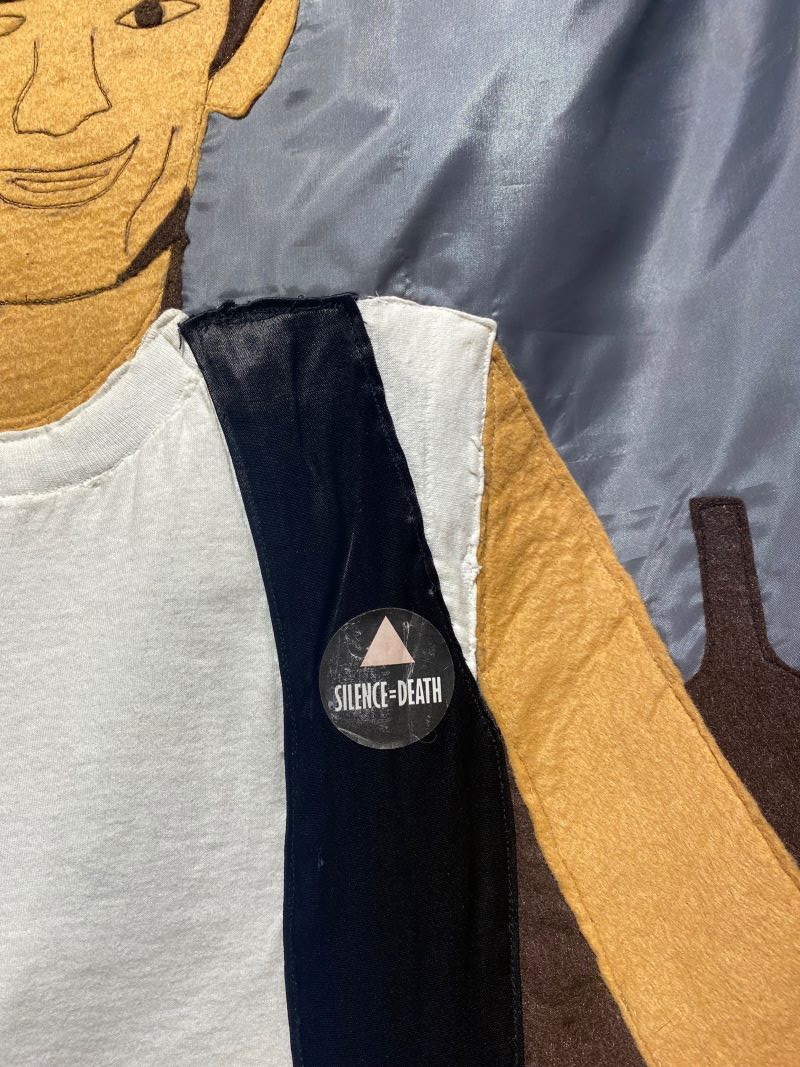
Paco served in the Air Force and was a bartender. He was known for his joy. ©Ed Lisowski. In memory of Paco (Paul David) Arbogost. Property of GCAP, Urbana, IL. Photo by Julie McClure with permission from Spurlock Museum.
The exhibit will be on display through July 10th, and there will be various events tied to the exhibit. There will be an official opening on January 30th, there is an upcoming online discussion about Angels in America, there will be guided tours, and Watkins hopes for some appearances by those involved in AIDS work during that time, including Carden and Julie Pryde. She is also looking to incorporate panel discussions on AIDS as a global epidemic, and bring in stories of those who aren’t represented, including women and people of color, as well as those who served as caretakers.
To see more images of the panels on display, read their stories, and find scheduled events for the exhibit, visit the Spurlock Museum website. The work of GCAP continues in our community. Find out more about what they do and how to get involved here. You can follow the work of History Harvest, and dig into their archive of C-U LGBTQ+ history here.








